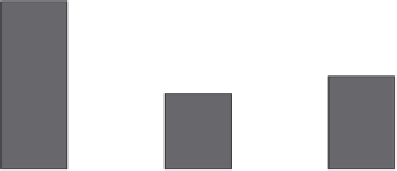Environmental Engineering Reference
In-Depth Information
120
Evaporation
Transpiration
100
80
60
40
20
0
No intervention
Micro WH
Macro WH
FIGURE 22.12
Percent beneficial use (transpiration) of rainwater under different
interventions.
usually less than 200 mm, compared to crop basic needs. It is unfavorably distrib-
uted over the crop-growing season and often comes with high intensity. As a result,
direct rainfall in this environment cannot support economical dry farming.
In the Mediterranean areas, rain usually comes in sporadic, unpredictable
storms and is mostly lost in evaporation and runoff, leaving frequent dry peri-
ods during the crop-growing season. Part of the rain returns to the atmosphere,
directly from the soil surface by evaporation after it falls, and part flows as surface
runoff, usually joins streams, and flows to swamps or to “salt sinks,” where it
loses quality and evaporates; a small portion joins groundwater. Lack of vegetative
cover, degraded soils, and the absence of proper management result in losing about
90 percent of rainwater by evaporation back to the atmosphere or by flow to salt
sinks (Figure 22.12). Moreover, the lost water causes serious erosion and acceler-
ate desertification. Water harvesting is the most effective technique to efficiently
utilize this water. This simple intervention allowed runoff water to concentrate
in smaller areas and be stored in the plants' root zone, supplying needed water to
crops and changing the whole scene.
This is the practice of concentrating rainwater, by depriving part of the land of
its share of rainwater (which is usually small and nonproductive) and adding it to the
share of another part (usually smaller in area) through runoff for beneficial use. The
concept of water harvesting differs from that of soil water conservation in which no
land is intentionally deprived of its share of rainwater.
Water harvesting systems are broadly classified into two major types:
•
The microcatchment systems where surface runoff is collected from a
small catchment area and where sheet flow prevails over short distance.
Runoff water is usually applied to an adjacent agricultural area to be stored
in the root zone and used directly by plants or stored in a small reservoir for
later use. The target area may be planted with trees, bushes, or with annual
crops. Farmer has the control within his farm over both the catchment and
the target areas.







Search WWH ::

Custom Search